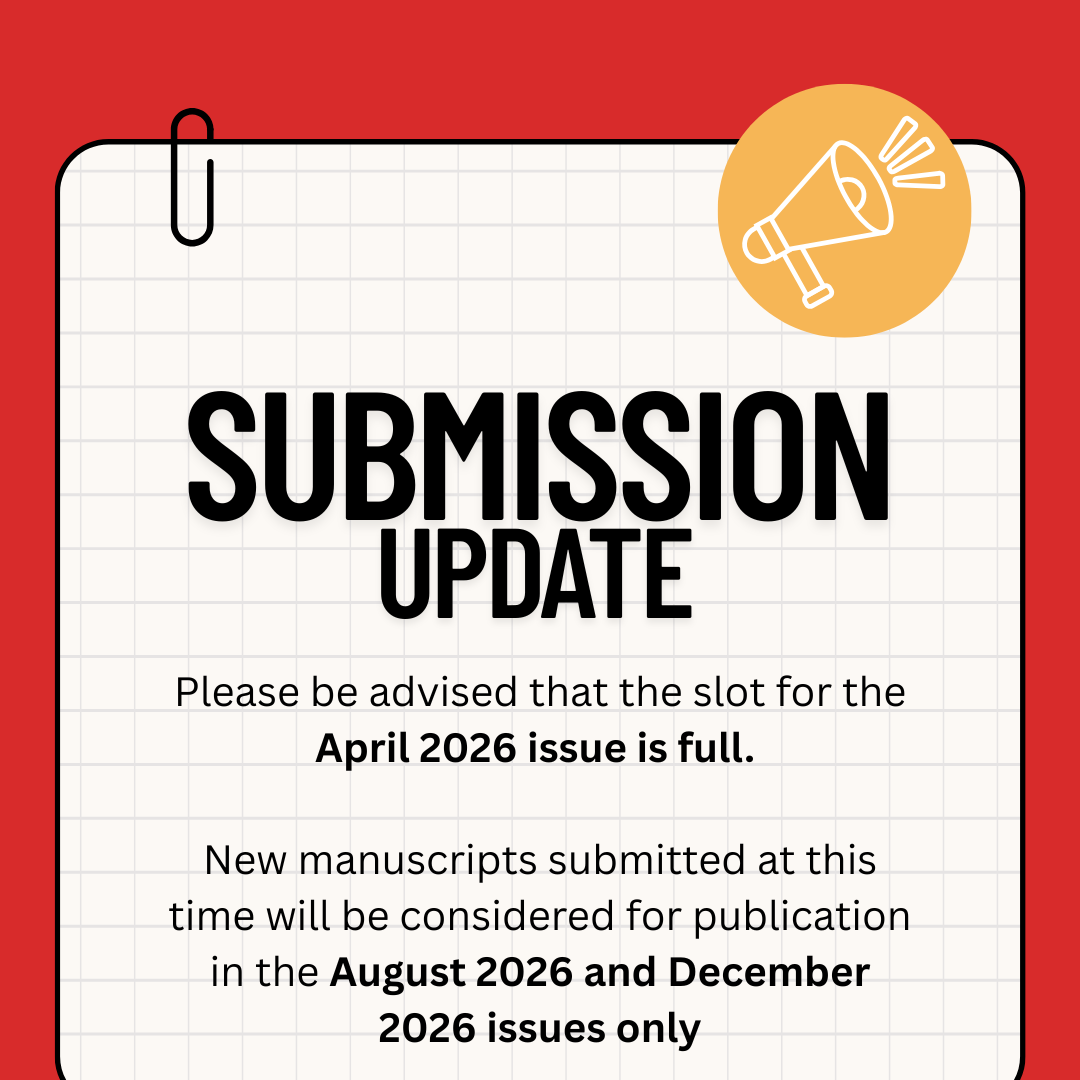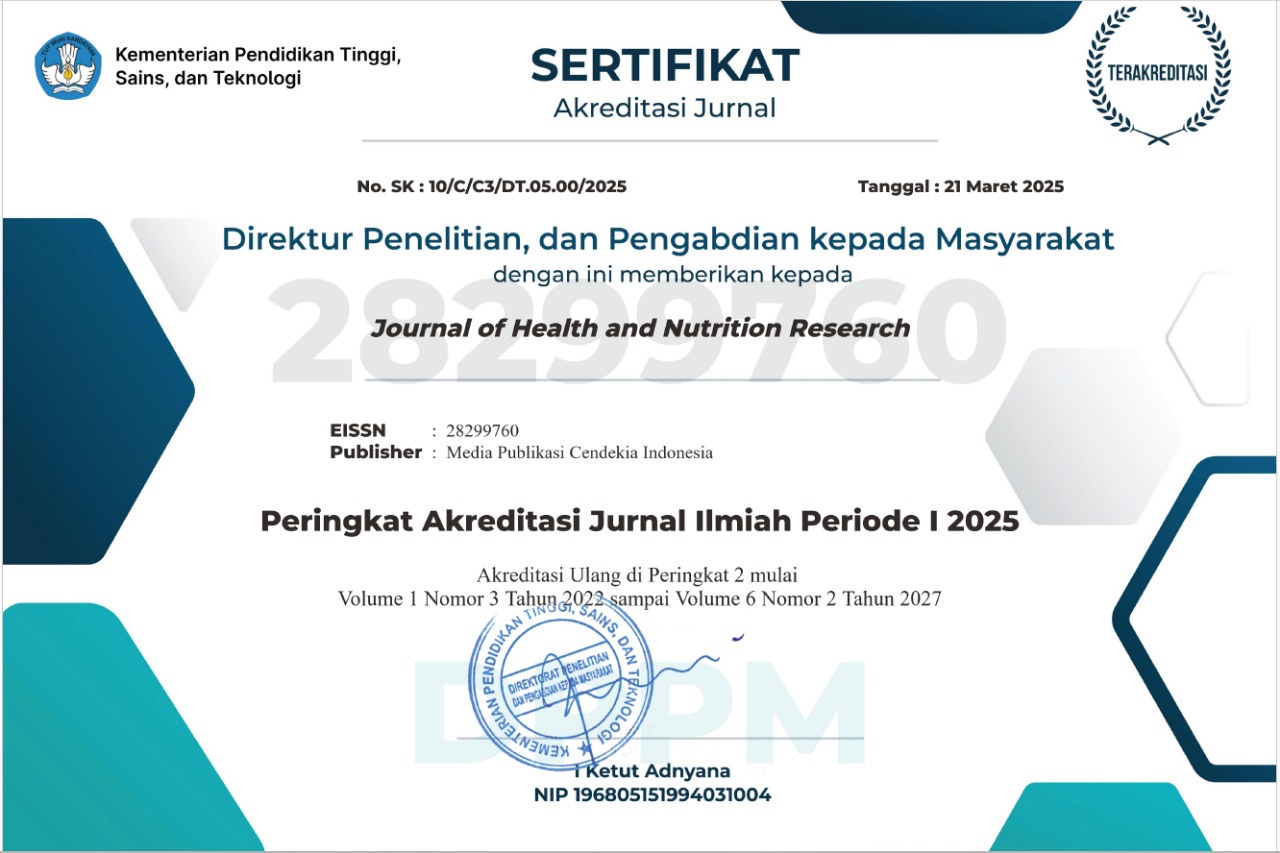The Risks of Sexual and Reproductive Activity on the Occurrence of Cervical Cancer in Central Sulawesi Province: Case Study of patients of Undata Hospital
Keywords:
Age of First Sexual Activity, Parity, Use of Hormonal Contraceptives, Exposure to Cigarette Smoke, Cervical CancerAbstract
This study aimed to determine the risk of age at first having sexual intercourse, parity, use of hormonal contraception, and exposure to cigarette smoke for the incidence of cervical cancer in Undata Hospital. This type of research was a quantitative method with a case-control approach. Case samples were 48 people, and control samples were 48 people with matching ages. Sampling was done by purposive sampling. The data source used secondary data from medical record records for 2021-2022 and primary data obtained through interviews with questionnaires. Data analysis used the odds ratio test, and the results showed that age at first sexual intercourse (OR= 2.333; CI = 1.029-5.292), parity (OR= 4.000; CI = 1.712-9.346), use of hormonal contraception (OR= 2.600; CI = 1.130-5.984), and exposure to cigarette smoke (OR= 1.486; CI = 0.539-4.100), are risk factors for cervical cancer. To overcome the incidence of cervical cancer, women of childbearing age and sexually active are expected to be routinely screened by doing pap HPV smear and vaccination
Downloads
References
Smith RA, Andrews KS, Brooks D, Fedewa SA, Manassaram‐Baptiste D, Saslow D, et al. Cancer screening in the United States, 2019: A review of current American Cancer Society guidelines and current issues in cancer screening. CA: A Cancer Journal for Clinicians. 2019;69(3):184–210.
Aziyah aziyah, Sri Sumarni N. Faktor Risiko yang Berhubungan dengan Kejadian Kanker Servik: Studi Kasus di RSUP Dr. Kariadi Semarang. Jurnal Riset Kesehatan. 2017;6(1):20.
UNFPA Asia-Pacific Regional Office. Cervical Cancer Elimination Country review and roadmap for action. UNFPA Asia-Pacific Regional Office. 2022;(January).
Marc Arbyn, Elisabete Weiderpass, Laia Bruni, Silvia de Sanjosé, Mona Saraiya, MD,f Jacques Ferlay and FB. Estimates of incidence and mortality of cervical cancer in 2018: a worldwide analysis. Lancet Glob Health. 2020;8(2):e191–203.
Jaime G.de la Garza-Salazar, Flavia Morales-Vasquez AMG. Cervical Cancer. Springer International Publishing Switzerland; 2017.
Kementerian Kesehatan RI. Profil Kesehatan Indonesia. Jakarta: Kementerian Kesehatan RI; 2018.
World Health Organization. Global Cancer Observatory. 2018.
Dinas Kesehatan Provinsi Sulawesi Tengah. Profil Kesehatan Provinsi Sulawesi Tengah. Palu; 2021.
Peraturan Menteri Kesehatan Republik Indonesia. No 34. Management of Breast Cancer and Cervical Cancer. No. 34. 2015.
Undata R. Data Rekam Medik Rumah Sakit Umum Daerah (RSUD) Undata. 2021.
Kashyap N, Krishnan N, Kaur S, Ghai S. Risk Factors of Cervical Cancer : A Case ‑ Control Study. 2019;
Saadoon IH. abnormal cervical Pap smears results in Nineveh governorate patient ’ s women. 2018;24(July):148–58.
Setianingsih E, Astuti Y, Aisyaroh N. Literature Review : Faktor-Faktor Yang Mempengaruhi Terjadinya Kanker Serviks. Jurnal Ilmiah PANNMED (Pharmacist, Analyst, Nurse, Nutrition, Midwivery, Environment, Dentist). 2022;17(1):47–54.
Meihartati T. Hubungan faktor predisposisi ibu terhadap kanker servik. Jurnal Darul Azhar. 2017;4(1):6.
Mayrita, S.N. NH. Hubungan Antara Paritas Dengan Kejadian Kanker Serviks Di Yayasan Kanker Wisnuwardhana Surabaya. Jurnal Ilmiah Kesehatan. 2014;7(1):1–7.
Phaiphichit J, Paboriboune P, Kunnavong S, Chanthavilay P. Factors associated with cervical cancer screening among women aged 25–60 years in Lao People’s Democratic Republic. PLoS ONE. 2022;17(4 April):1–11.
Ashar H, Kusrini I, Musoddaq A, Asturiningtyas IP. First sexual intercourse and high parity are the most influential factors of precancerous cervical lesion. Majalah Obstetri & Ginekologi. 2020;28(3):113.
Tekalegn Y, Sahiledengle B, Woldeyohannes D, Atlaw D, Degno S, Desta F, et al. High parity is associated with increased risk of cervical cancer: Systematic review and meta-analysis of case–control studies. Women’s Health. 2022;18.
Pratiwi SE, Trianto HF, Fatinah NN, Ilmiawan MI, Fitrianingrum I, Lestari D. The Profile of Cervical Cancer Patients at Soedarso Hospital. Indonesian Journal of Cancer. 2022;16(1):33.
Kusmiyati Y, Prasistyami A, Wahyuningsih HP, Widyasih H, Adnani QES. Duration of hormonal contraception and risk of cervical cancer. Kesmas. 2019;14(1):9–13.
Iversen L, Fielding S, Lidegaard Ø, Hannaford PC. Contemporary hormonal contraception and cervical cancer in women of reproductive age. International Journal of Cancer. 2021;149(4):769–77.
Published
How to Cite
Issue
Section
Copyright (c) 2022 Dilla Srikandi Syahadat, Ni Made Eviyulianti, Muh. Jusman Rau, Elvaria Mantao, Sendhy Krisnasari

This work is licensed under a Creative Commons Attribution-NonCommercial-ShareAlike 4.0 International License.
Most read articles by the same author(s)
- Vidyanto Vidyanto, Brigita Natasya Bertus, Sendhy Krisnasari, Muhammad Ryman Napirah, Analysis of Satisfaction Levels of Patients on Service Quality with The Importance Performance Analysis (IPA) Method , Journal of Health and Nutrition Research: Vol. 2 No. 3 (2023)
- Muh. Jusman Rau, Nurjannah Nurjannah, Dilla Srikandi Syahadat, Hasanah Hasanah, Determinants of Risk for Type 2 Diabetes Mellitus Among the Community at The Birobuli Community Health Center , Journal of Health and Nutrition Research: Vol. 3 No. 1 (2024)
- Arwan Arwan, Syamsul Arif, Sadli Syam, Muhammad Ryman Napirah, Sendhy Krisnasari, Firmansyah Firmansyah , Novi Inriyanny Suwendro, Bullying Behavior in Generation Z Youth: Case Study at Palu City DP3A Children's Forum , Journal of Health and Nutrition Research: Vol. 2 No. 3 (2023)
- Kiki Sanjaya, Pitriani Pitriani, Putri Trisnowati, Febi Dwi Handayani, Muh. Jusman Rau, Hermiyanty Hermiyanty, The Effect of Climate Change on Environmental-Based Diseases in Palu City in 2015-2020 , Journal of Health and Nutrition Research: Vol. 1 No. 1 (2022)
- Marselina Palinggi, Muh. Jusman Rau, Nur Hikma Buchair, Annisa Raudhatul Jannah, Rahmania, Moh. Fikram Dg Sirata, Factors Associated with Decreasing Incidence of Stunting in the Working Area of the Palu Health Center , Journal of Health and Nutrition Research: Vol. 2 No. 1 (2023)
- Sitti Radhiah, Nur Khairul Fatassya, Hasanah Hasanah, Elvaria Mantao, Risk Factor for Postpartum Hemorrhage in The Post-Disaster (2019-2021) , Journal of Health and Nutrition Research: Vol. 2 No. 3 (2023)
- Sendhy Krisnasari, Tresia Aulia, Dilla Srikandi Syahadat, Marsellina Marsellina, Bertin Ayu Wandira, The Relationship of Environmental Factors and Nutritional Status and The Incidence of ARI of Toddler in the Working Area of Donggala Public Health Center , Journal of Health and Nutrition Research: Vol. 1 No. 1 (2022)
- Hasanah, Muafiah Basir, Herawanto, Muh. Jusman Rau, Factors Influencing the Discovery of Suspected Tuberculosis during the COVID-19 Pandemic in Palu City , Journal of Health and Nutrition Research: Vol. 1 No. 3 (2022)
- Elvaria Mantao, Rahma Dwi Larasati, Marselina, The Role of Self-Practice Midwife on Maternal Health Services for The Period of The Covid-19 Pandemic in Palu City , Journal of Health and Nutrition Research: Vol. 1 No. 3 (2022)



















